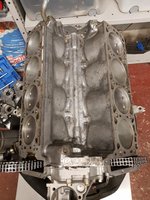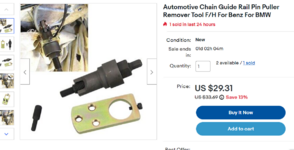I did get the timing cover removed a couple days ago. Not the easiest task – it’s a tight fit! Taking the upper sum pan off is almost essential I would say. That’s how I got mine off. Note that the upper sump pan comes off then the oil pump comes off.
Interesting at 45 degrees before TDC the oil level sender will NOT come out. The con rod big end cap blocks it from coming out. So that sucks – you must then move the crank to get the single pin plug out of the block. I preferred doing that than taking off the other end of the sender unit at the oil pump and risk breaking the wire.
Then a small copper faced dead blow hammer was used to knock the timing cover free. Do take the crank bolt off and the oil pump chain just hangs there – you can’t get it off the sprocket. So the timing cover is taken off and tilted out and down to clear the oil pump chain.
The new Febi timing chain kit arrived today, was made in Germany and has a Swag tensioner with IWIS chain. All looks good and OEM quality. I did check the chains and they are a match albeit you can just see the older chain is a tiny fraction longer due to wear. Good idea to be changing it then. It sure is nice to be replacing all of the guides.
Note also that the new IWIS timing chain came as one piece – therefore if you do not take the timing cover off I think you might have to split a link and re-crimp it However since my timing cover is off the chain will set in there and go where it needs to with ease as one piece.
However since my timing cover is off the chain will set in there and go where it needs to with ease as one piece.
Also – there was old guide shrapnel in inaccessible areas behind the timing cover so it is good to give it a thorough clean up. Waiting on the 2x new O rings and sealant from the dealer (With a huge laundry list of sundries) before I can fit the timing cover back on. But I might also wait until I have the valve stem oil seals changed as I will need to be turning the crank to do that and I do not want the chain binding up behind there.


Interesting at 45 degrees before TDC the oil level sender will NOT come out. The con rod big end cap blocks it from coming out. So that sucks – you must then move the crank to get the single pin plug out of the block. I preferred doing that than taking off the other end of the sender unit at the oil pump and risk breaking the wire.
Then a small copper faced dead blow hammer was used to knock the timing cover free. Do take the crank bolt off and the oil pump chain just hangs there – you can’t get it off the sprocket. So the timing cover is taken off and tilted out and down to clear the oil pump chain.
The new Febi timing chain kit arrived today, was made in Germany and has a Swag tensioner with IWIS chain. All looks good and OEM quality. I did check the chains and they are a match albeit you can just see the older chain is a tiny fraction longer due to wear. Good idea to be changing it then. It sure is nice to be replacing all of the guides.
Note also that the new IWIS timing chain came as one piece – therefore if you do not take the timing cover off I think you might have to split a link and re-crimp it
 However since my timing cover is off the chain will set in there and go where it needs to with ease as one piece.
However since my timing cover is off the chain will set in there and go where it needs to with ease as one piece.Also – there was old guide shrapnel in inaccessible areas behind the timing cover so it is good to give it a thorough clean up. Waiting on the 2x new O rings and sealant from the dealer (With a huge laundry list of sundries) before I can fit the timing cover back on. But I might also wait until I have the valve stem oil seals changed as I will need to be turning the crank to do that and I do not want the chain binding up behind there.







 ) An m119 timing cover re-seal in the car would be very difficult.
) An m119 timing cover re-seal in the car would be very difficult.








 . This tells me that #110, at least on the passenger side, is intact. Odometer is at 148,500 mi
. This tells me that #110, at least on the passenger side, is intact. Odometer is at 148,500 mi 


















 :
:






